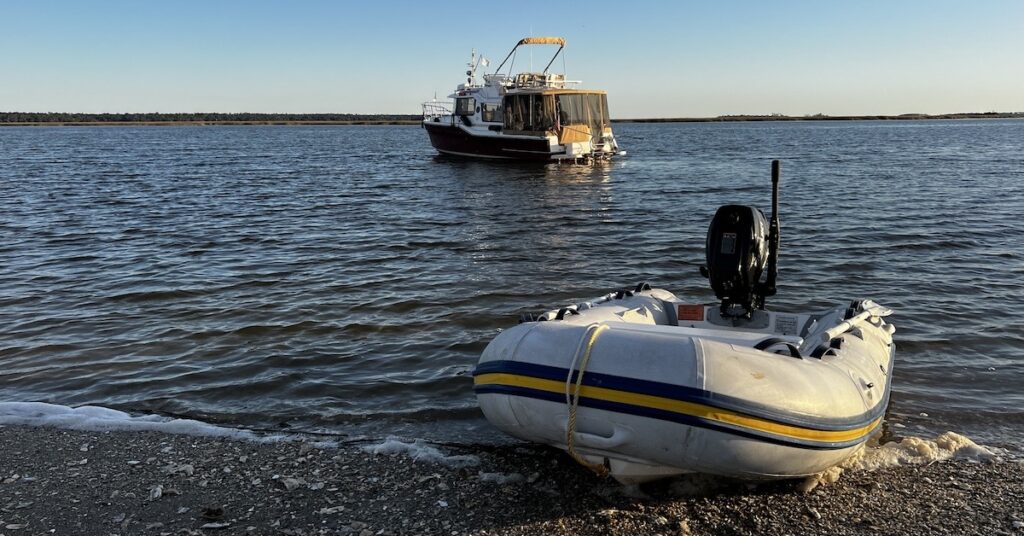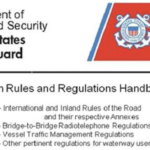Don’t just buy the boat some online forum tells you to buy. Think about what you want and need and buy the best boat for your Great Loop journey.
If you live in an area where you can see cruising boats — perhaps you live near the Great Loop route? — get out to marinas and meet the folks who are cruising. Talk to them about their boats, get an idea for what they like and don’t like. What they consider must-have features. See if you can tours their boats. And, of course, work with boat brokers in your area to tour as many boats as you can. See how they stack up against each other. See what you like and don’t like.
I’m in the process of choosing my next cruising boat. While I might do the Great Loop again, I’m more interested in cruising in the waterways north of New York City, including the Hudson River, New York Canals, Lake Champlain, and Canadian rivers and canals. I have some ideas of what I might want to buy, but i’m not making a choice without actually climbing on board a bunch of boats to see them for myself. To that end, I’ll be visiting the Seattle Boat Show in February, making a special effort to get out to the marina and see the used boats for sale. Although I do not plan on buying a boat in the Seattle area (which I’d then have to ship east), Seattle is close enough to where I live to start narrowing down my options.
Whatever you do, don’t buy a boat based on a recommendation without actually seeing and walking through the boat. No one knows what’s best for you better than you do.
One of the most commonly asked questions on Great Loop forums is: What is the best Loop boat? And time after time, one boat comes out as the answer: Mainship. And dozens of people blindly go out and buy used Mainships to do their Loops.
I don’t know about you, but when I make a large purchase decision — like the purchase of a boat I plan to spend more than a year aboard in all kinds of conditions — I like to do a little more homework than ask a bunch of strangers what I should buy. If you’d like to do your homework, this blog post will help you get a better idea of what you should be looking for.
Size Matters
For doing the Loop — or for any long cruise — the size of a boat might be one of the first things you consider. It needs to be large enough to be comfortable while being small enough for you and your crew to handle in all conditions. It also needs to have a short enough air draft to fit under the lowest fixed bridge and have a shallow enough draft to cruise comfortably in all waterways along the Loop.
Here are a few specific size constraints.
Air Draft
In general, it’s impossible to complete the Great Loop with an air draft higher than 19’6″.
If your ideal Loop boat is a sailboat, be prepared to step down the mast for the inland waterways and New York State Canal system. Fortunately, you’ll find marinas in Chicago, Mobile, the Hudson River, and Buffalo that can help you with your mast.
Beyond that restriction, there are two points along the loop where air draft really matters:
- If you take the Chicago River Route between Lake Michigan and the Illinois River, you’ll need to pass under the Conrail CSX Railway Bridge. This is a fixed bridge with a clearance of 17’6″. You can bypass this bridge (and the whole downtown Chicago portion of the Loop) by taking the Calumet River route between Lake Michigan and the Chicago Sanitary and Ship Canal.
- There are a number of fixed bridges along the Erie Canal (and other New York State Canal Corporation canals) that have clearances of 15’6″ at normal water surface elevation. If water levels are high — as they can be during a lengthy rain event — the clearances are lower, sometimes dipping below 15 feet. (It’s highly recommended that you consult the Bridge Heights Information section on the Boating Information page for the New York Canal Corporation before attempting to travel along the Erie Canal in a boat with an air draft greater than 14 feet.)
Draft
I can tell you from first-hand experience that there are plenty of shallow channels along the way, especially with the ever shifting sands in the Atlantic Intracoastal Waterway. While a boat with a 5-foot draft should be able to make it with careful and skillful navigation and a close eye on recently updated USCG soundings information (which is available in apps like Aqua Map), less is better. The general recommendation is 4 feet or less.
And don’t trust your charts or chartplotter without recent sounding information! My 2 1/2 foot draft Ranger Tug soft grounded in an area of the ICW charted on my Garmin Chartplotter at 12 feet.
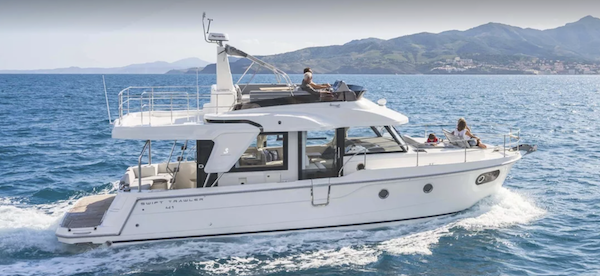
This Swift Trawler is in the running for my next cruising boat.
Bigger Isn’t Always Better
Let’s take a look at overall size. You’ll likely be on the boat for at least 10 months, but if you take your time doing it, take a few breaks, and perhaps do some side trips — as I did — you could be on the boat on and off for years. It needs to be comfortable enough for your crew and any temporary guests who might join you for a while. One berth, two berths, more? One head, two heads?
You also need a boat you and your crew can handle. If you’re new to cruising — and I can’t tell you how many people I met on the Great Loop who were brand new to it — you need to get a boat you feel comfortable docking, casting off, anchoring, and maneuvering, sometimes in tight places. If you get a larger boat than you’re comfortable with at first, take the time to get comfortable with it before departing on your Great Loop journey. Work with an experienced captain and practice what you’ll need to do. You will not enjoy your trip if you’re afraid of your boat or are unable to handle it safely.
Remember that when you stay overnight at a marina, they’ll charge you based on the size of your boat. With rates in Florida, New York City, and elsewhere sometimes exceeding $5 per foot per night, dock fees add up quickly. Larger boats also tend to be more costly to operate and maintain, so if you’re on a budget, keep that in mind when choosing your boat.
Finally, consider this: the average size of Great Loop cruiser boats is 40 feet. Yet I know several Gold Loopers — including me! — who have completed the loop in a much smaller boat: 28 to 35 feet. (Mine is 32 feet LOA.) Don’t buy a bigger boat than you want or need just because everyone else does. During my Loop, I was able to get into tight, shallow spots that most other Loop boats couldn’t. This incredible flexibility really made my trip special and extra memorable.
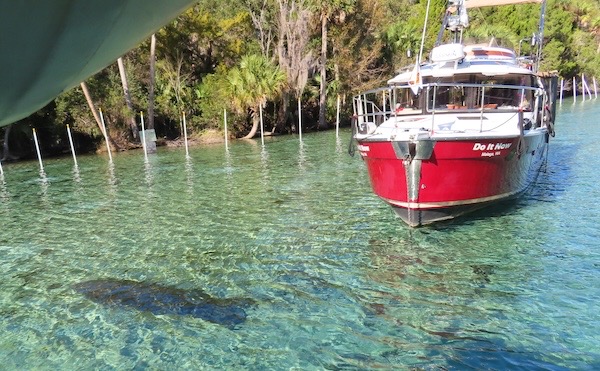
My 2 1/2 foot draft made it possible me to get into a lagoon full of manatees and anchor in just 4 feet of water. Photo was shot from a Rosborough parked nearby.
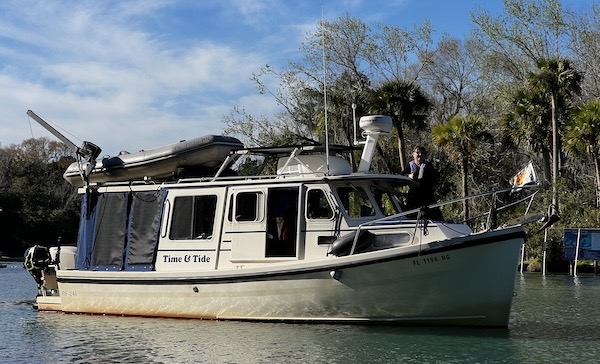
And here’s Time & Tide, that Rosborough that was in the lagoon with me. They did the Loop in this boat.
How Many Engines?
Cruising boats come with one or two engines. What’s available usually depends, at least in part, on the size of the boat. Larger boats often have two engines while smaller boats usually have just one. But there are exceptions, of course.
Some people prefer two engines because they figure that if one engine quits, the other engine can get them someplace for repairs. I understand that, but two engines also cost twice as much to feed and maintain, with the potential to seriously increase the cost of the trip.
Another benefit of a twin-engine boat is that it’s easier to maneuver in close quarters than a single.
(I’m firmly in the single engine school of thought and won’t even consider a twin engine boat for my next boat. I have Boat US coverage in case that engine fails.)
Helm Features
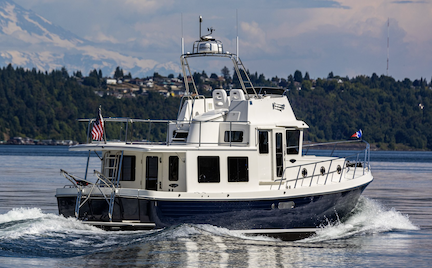
American Tugs are also good trawlers.
Nowadays, boats can come with a wide range of features to help the captain navigate and maneuver the boat. Old-time purists (or people who don’t know any better) may think we’re all navigating on paper charts with plotters and other tools, hand-steering every step of the way. I don’t and I don’t know anyone who does. My boat has the tools to reduce my workload — which is vital since I’m cruising alone most of the time — and if you have the opportunity to buy a boat with these features, why wouldn’t you?
Here are some of the things I’m talking about:
- Chartplotter can give you moving map positioning and trip-planning/routing capabilities. You should have one at each helm station. (My little boat has three.)
- Autopilot slaved to the chart plotter can not only keep you pointed in the right direction (Heading Hold), but get you directly to a specific point (GoTo), or steer the boat along a route you specify (Follow Route). If you’re doing a 6000+ mile trip, you’re really going to want to use an Autopilot.
- AIS In/Out displayed on the chartplotter identifies other AIS-equipped boats, including all commercial boats in the US, and sends information about your boat to other AIS-equipped boats. AIS In, at a minimum, should be required equipment when cruising down the inland waterways. How else will you see the barge ahead of you before it rounds the bend in the river?
- Radar displayed on a chart plotter can help you identify potential obstructions and hazards, including other traffic, in low visibility situations.
- Sonar or depth indicator can tell you how deep the water is right beneath the boat.
- Rudder indicator tells you the position of your rudder, which is extremely handy for slow maneuvering near docks and other obstacles. Remember, a hard turn will swing your stern around and it could make contact with a dock or another vessel.
- Thrusters make it easy for a single engine boat to maneuver in close quarters at slow speeds. For the best setup, you want a bow thruster and a stern thruster. And although these aren’t as helpful on twin engine boats, which are generally easier to maneuver, they certainly can’t hurt.
And while we’re talking about helms, decide up front whether you want a command bridge (or fly bridge) helm in addition to (or instead of) an inside helm. I love driving from up on my command bridge, but I also like the option of driving from inside when the weather isn’t pleasant. Some boats also have starboard side aft helms in the aft cockpit. Those can be very handy for docking. I don’t have one of those but often wish I did. (Remember, I’m a mostly solo cruiser.)
Other Features
Here are a few other features you might want to consider:
- Galley setup. If you plan on cooking on board, make sure the galley setup is sufficient and doesn’t require you to be connected to shore power. The size of the refrigerator and space for dry goods storage is important, too.
- Electrical system. If you plan to spend a lot of time at anchor, you need to make sure your electrical system can support multiple days without shore power. The number and type of batteries, solar panels, inverter, and an integrated generator are things to consider.
- Air conditioning. On the great loop, you’ll be south in the winter and north in the summer. Although I prefer not to use air conditioning (and don’t have it in my boat), the northeast, from around Cape May to the Great Lakes, can get pretty darn humid when you’re likely to be there in July and August.
- Sufficient relaxation space. You’ll spend some time sleeping, some time cruising, some time eating, and some time just relaxing on board. Be sure you have sufficient space for all of those activities for your entire crew. (The one thing I long for is a recliner on board my boat.)
- Dinghy Setup. If you think you’ll need to go to shore a lot, make sure your dinghy setup is something you can live with. You need to be able to launch and retrieve the dinghy with the least amount of effort.
- Light and ventilation. I went with a trawler because I like the big windows and bright daytime most trawlers offer. I also like the fact that I can open different combinations of windows for airflow when needed.
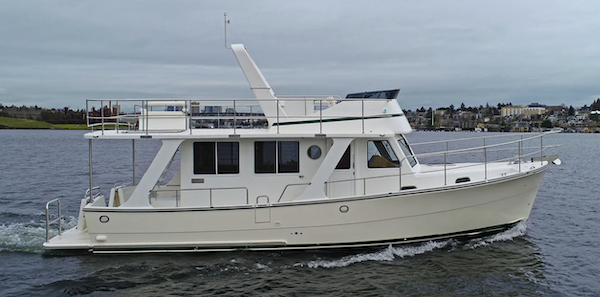
I’m also considering a Helmsman trawler.
Boat Age
Generally speaking, the older the boat is, the more wear and tear it might have on it. That means the more things that could go wrong along the way. But this isn’t always true. If you’re lucky enough to buy a gently used older boat, everything might work perfectly. (You really need to get any boat you’re serious about buying inspected by a qualified marine surveyor.)
Another drawback to an older boat is the age of its navigation features as discussed in the previous section. No one wants a boat with a Loran system on it instead of a reliable GPS chartplotter. And what good is an add-on autopilot if the only feature it gives you is Heading Hold because it can’t talk to the chartplotter?
The benefit of an older boat, however, is that it’s usually a lot less expensive to acquire. But consider how much money you’ll have to put into it to add the improvements you want or need for your trip. Sometimes it’s just better to buy a newer boat and pay up front for the features it has.
I was very fortunate when I bought my boat. It was 3 years old but only had 30 hours on its Volvo engine. The refrigerator, microwave, and stove had never been used. It had probably never even been slept on. It was like a brand new boat at a used boat price.
Of course, if you have the money for a new boat and don’t mind spending it, go for it! I sure would!
It’s Up to You
Again, I can’t stress how important it is for you to do your homework and find the boat that’s right for you — not the boat a bunch of strangers on a web forum recommend.
I think my Ranger Tug R-29 CB is the perfect Great Loop boat — for me. Unless you have your heart set on a bigger or twin engine boat, I recommend you check it out. But I won’t say it’ll be the perfect boat for you.
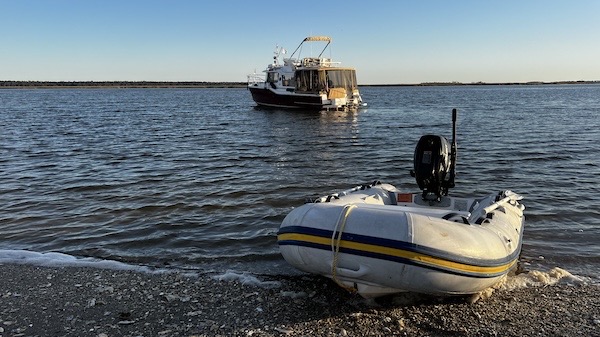
I got my Ranger Tug and its dinghy setup completely dialed in about halfway through my Great Loop journey.
That’s up to you.
